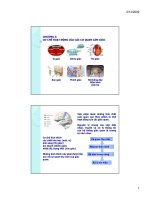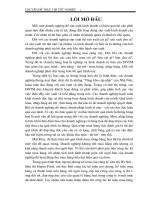Food microbiology
Bạn đang xem bản rút gọn của tài liệu. Xem và tải ngay bản đầy đủ của tài liệu tại đây (155.61 KB, 56 trang )
FOOD MICROBIOLOGY
Prof. Jackson N. Ombui
Department of Public Health, Pharmacology and Toxicology,
University of Nairobi.
Introduction
•Food production occurs at specific areas and
at certain periods of the year due to variation
in weather conditions.
•Food therefore has to be collected and stored
for use during periods of low or no food
production.
•However, storage is complicated by the fact
that food begin to deteriorate shortly after
harvest, gather or slaughter.
Food spoilage
•Food spoilage is defined as damage or
injury to food rendering in unsuitable for
human consumption.
• Food must be considered spoiled if it is
contaminated with pathogenic
microorganisms or various poisonous
agents, such as pesticides, heavy metals
etc.
Table 1: Storage life of some foods
Food product
Storage life (days) at 21oC
Raw beef and mutton
Raw fish
Raw poultry
Dried salted or smoked
meat and fish
1-2
1-2
1-2
360 or more
Fresh fruits
Dried fruits
Leafy vegetables
Root crops
Dried seeds
1-7
360 or more
1-2
1-20
360 or more
Food spoilage cont….
•In most cases there does not need to be an
evident sign of spoilage, the food might look
normal and only after eating it or by careful
bacteriological and toxicological
investigation, one is able to realize the
defect.
•Food decay or decomposition is implied
when the term spoiled is used.
Causes of food spoilage
• (a). Growth and activity of microorganisms
Bacteria, yeasts and molds are microorganisms
that cause food spoilage. They produce various
enzymes that decompose the various
constituents of food.
• (b). Enzyme activity: Action of enzymes found
inherently in plant or animal tissues start the
decomposition of various food components after
death of plant or animal.
• (c). Chemical reactions: These are reactions that
are not catalysed by enzymes.,e.g. oxidation of
fat
Causes of food spoilage cont…
•(d). Vermin. Vermin includes weevils, ants,
rats, cocroaches, mice, birds, larval stages of
some insects. Vermin are important due to:
(i). Aesthetic aspect of their presence,
(ii) Possible transmision of pathogenic agents,
(iii). Consumption of food.
•(e). Physical changes. These include those
changes caused by freezing, burning, drying,
pressure, etc.
Microbial spoilage of food
•Bacteria, yeasts and molds are the major
causes of food spoilage.
•They produce various enzymes that
decompose the various constituents of food.
•Molds are the major causes of spoilage of
foods with reduced water activity e.g dry
cereals and cereal product
•Bacteria spoil foods with relatively high water
activity such as milk and products.
Sources of microorganisms in food
The primary sources of microorganisms in food include:
1.
2.
3.
4.
5.
6.
7.
Soil and water
Plant and plant products
Food utensils
Intestinal tract of man and animals
Food handlers
Animal hides and skins
Air and dust
Factors affecting microbial growth in food
(a)Intrinsic factors:
These are inherent in the
food. They include:
Hydrogen ion concentration (pH),
moisture content,
nutrient content of the food,
antimicrobial substances ad
biological structures.
1. Hydrogen ion concentration (PH)
•Most bacteria grow best at neutral or weakly
alkaline pH usually between 6.8 and 7.5.
•Some bacteria can grow within a narrow pH
range of 4.5 and 9.0, e.g. salmonella
• Other microorganisms especially yeasts and
molds and some bacteria grow within a wide
pH range, e.g. molds grow between 1.5 to 11.0,
while yeasts grow between 1.5 and 8.5.
Table 2: pH values of some food
products
Food type
Beef
Chicken
Milk
Cheese
Fish
Oyester
Fruits
Vegetables
Range of pH values
5.1 - 6.2
6.2 – 6.4
6.3 – 6.8
4.9 - 5.9
6.6 - 6.8
4.8 - 6.3
< 4.5 (most < 3.5)
3.0 – 6.1
• Microorganisms that are able to grow in acid
environment are called acidophilic
microorganisms.
• These microorganisms are able to grow at pH of
around 2.0.
• Yeasts and molds grow under acid conditions.
• Other microorganisms such as vibrio cholerae are
sensitive to acids and prefer alkaline conditions.
• Most bacteria are killed in strong acid or strong
alkaline environment except Mycobacteria.
Table 3: Minimum and maximum pH for growth of
some specific microorganism
Microorganism
Minimum
Maximum
Escherihia coli
4.4
9.0
Salmonella typhi
4.5
8.8
All bacteria
4.0
9.0
Molds
1.5
11.0
Yeast
1.5
8.5
2. Moisture content
• The effect of moisture is in terms of water
activity: -the amount of free water in a food
medium.
• The amount of free water is important for growth
of microorganisms.
• If there is lack of this free water microorganisms
will not grow.
• Water activity is defined as the vapour pressure
of a food substance to that of water at the same
temperature. (Aw = VPFood/VPWater)
Moisture content
•The water activity is therefore equal to 1.0.
•Food products have a water activity of less
than 1.0.
•A saturated salt solution has a water
activity of 0.75.
•Salting and drying reduces the water
activity of a food product.
Table 4: Water activity of some food
products.
Food Product
Water activity
Raw meat and milk
0.99- 1.0
Luncheon meat
0.95
Boiled ham, sliced bacon
0.90
Dried grains
0.80
Water activity levels
•Growth of microorganisms is greatly affected by
the level of water activity(Aw) in the food.
•Inhibition of growth occurs if the water activity
for food is lowered beyond an organism’s
minimum level of water activity that is
necessary for growth.
•Microorganisms have varied minimum water
activity requirements that supports their
growth in food.
Table 5: Minimum water activity that supports growth
of some microorganisms
Microorganism
Water activity
Clostridium botulinum,
Bacillus cereus,
Pseudmonas aeroginosa,
Salmonella spp.
0.95
0.95
0.95
0.95
Staphylococcus aureus (anaerobic),
Candida spp., Saccharomyces
0.90
Staphylococcus aureus (aerobic)
Penicillium spp.
Most spoilage yeast
Most spoilage molds
Osmotic yeast
0.86
0.82
0.88
0.80
0.70
3. Nutrients content of the food
• Microorganisms require proteins, carbohydrates,
lipids, water, energy, nitrogen, sulphur, phosphorus,
vitamins, and minerals for growth.
• Various foods have specific nutrients that help in
microbial growth.
• Foods such as milk, meat and eggs contain a number
of nutrients that are required by microorganisms.
• These foods are hence susceptible to microbial
spoilage.
Antimicrobial substances
•Antimicrobial substances in food inhibit
microbial growth.
•Various foods have inherent antimicrobial
substances that prevent (inhibit) microbial
attack.
•Such inhibitors are like lactinin and anticoliform factors in milk and lysozyme in
eggs.
Biological structures
•Some foods have biological structures that
prevent microbial entry.
•For example, meat has fascia, skin and
other membranes that prevent microbial
entry.
•Eggs have shell and inner membranes that
prevent yolk and egg white from infection.
(b). Extrinsic factors
•Are factors external to the
food that affect microbial
growth. They include:
1. Temperature of storage,
2. Presence and concentration of gases in the environment
3. Relative humidity of food storage environment.
1. Temperature
•The growth of microorganisms is affected
by the envirnmental temperatures.
•Various microorganisms are able to grow at
certain temperatures and not others.
•Bacteria can therefore be divided into the
following groups depending upon their
optimum tmperature of growth.
(i). Pyshrophilic microorganisms
•These grow best at about 20oC but
also down to -10oC in unfrozen media.
•Psychrophilic bacteria can cause food
spoilage at low temperatures.
•Several of the microorganisms found
in the soil and water belong to this
group.









